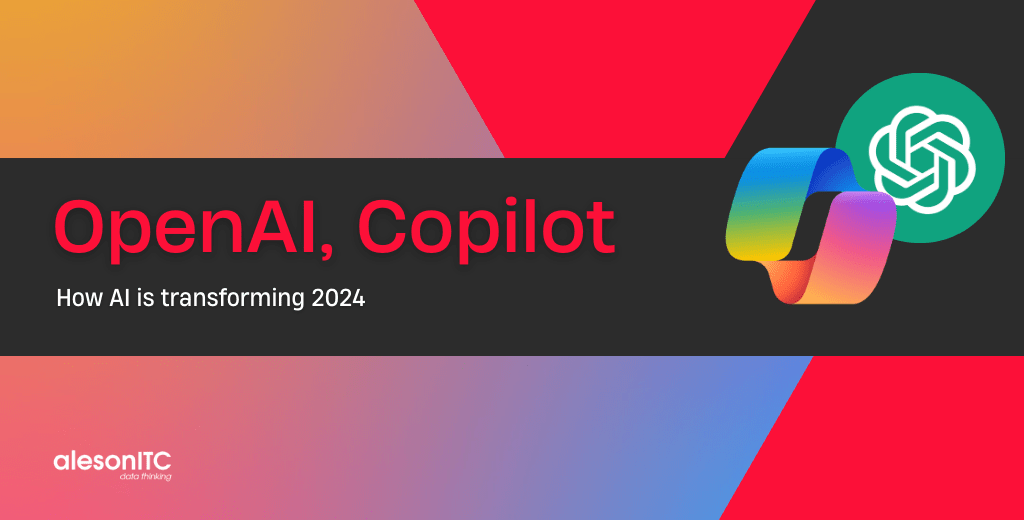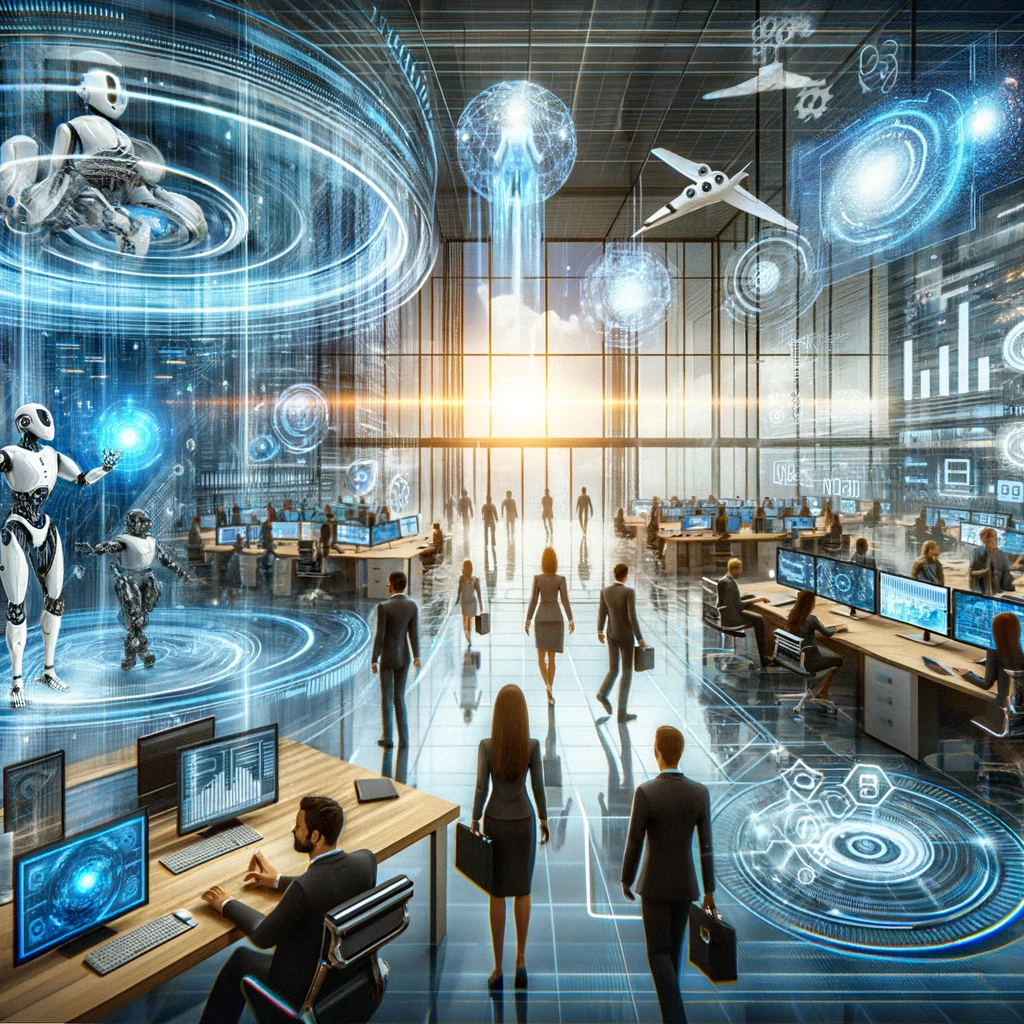OpenAI, Copilot: How AI is tranforming 2024

Welcome to a new post on the Aleson ITC blog. In today’s article we will talk about current trends and data on AI.
As 2024 unfolds, the world of technology continues to grow exponentially. AI, is at the forefront, offering possibilities in numerous sectors and fields.
Just so we’re all in context, the AI market could pass the $300 billion mark by 2025.

For this reason, in this Blog we would like to explain a series of trends that have emerged and that we cannot overlook.
1- Generative AI: An Expanding Horizon.
Generative AI has become the technology that has caught all eyes in 2024.
The precise impact of generative AI will depend on a variety of factors, but almost all sectors will see significant gains from the implementation of this technology.

Looking ahead, publications such as Forbes have already released their forecasts and we believe that the trends that are going to be crucial for generative AI are exponential mainly in the following areas:
1.1- Transformation in Software Development.
As mentioned above, the impact will be exponential, tools based on this technology can be applied to a very wide range of sectors with the aim of significantly reducing the time spent on tasks. This will not only accelerate development, but also improve the user experience.
1.2- Implications for the Education and Entertainment Industry.
Generative AI will gradually be introduced in schools to generate notes, reports, lesson plans, summaries, etc., thus transforming education by creating personalised learning experiences.
On the entertainment side, on the other hand, it is revolutionising film and media production. From the creation of advanced special effects to the digital regeneration of actors.
1.3- The rise of multimodal models
Multimodal machine learning models can handle data from multiple modalities: image, text, audio, video, temperature etc. …. to gain insight into content.
One example of multimodal models is “Flamingo”. Flamingo is a family of visual language models designed for learning from a few examples.

1.4 OpenAI
OpenAI is an organisation in artificial intelligence (AI), they are responsible for such relevant neural networks as GPT-3.
Microsoft has been a key partner and major investor in OpenAI. This collaboration has resulted in the integration of OpenAI technologies with the Azure platform, resulting in Azure OpenAI.
Main advantages of using Azure OpenAI:
Firstly, have controlled access as Azure OpenAI is designed for businesses that need additional controls over the use of AI, including security, compliance and privacy policies.
On the other hand, it allows and will allow us to have a scalability based on the needs of the organisation.
Another important point is the possibility of integrating services that we already have today in Azure with the combination of OpenAI, to create more complete and efficient solutions.
And finally, to have a customisation of the models to the specific needs of our organisation, training and adjusting the models.
These OpenAI developments will contribute to:
First, large multi-modal models will continue to have a transformational impact on organisations.
We will also see smaller and more specialised multimodal models and an increasing need to orchestrate them, in multi-agent networked ecosystems, where each generative agent is assigned to a specific task.
And as a final note, AI platforms will emerge to support all of this, because none of these innovations can become a reality if businesses do not have access to tools to help them take advantage of these innovations.
2- Microsoft Copilot: Revolutionize your Productivity with (AI)
2.1- How does Microsoft Copilot work?
Microsoft Copilot leverages advanced machine learning models to offer suggestions and accelerate productivity in our daily lives with the vast majority of Azure services, as we can see in the image.

The promise of Microsoft Copilot goes beyond simply helping us with our code. This tool is integrating with all the services Microsoft can provide us with to offer complete and optimised solutions. From unit test generation to API integration.
Main advantages of using Microsoft Copilot:
Firstly, the increase in productivity is exponential as it offers intelligent suggestions that help us to significantly reduce tasks in all departments.
On the other hand, it helps us at the training and learning level as it provides us with guidance and examples that consequently help us to accelerate our learning and continuous improvement.
And by integrating AI into our Azure services, organisations can explore new ideas and approaches that were previously impractical or too costly to implement.
With this functionality, teams can take a step further in the complete development of a project by integrating AI assisted code generation, as they are efficiently collaborating in building complete solutions.
In short, this tool is a transformative tool that is redefining the ways of programming by bringing greater robustness to code. Its impact will spread further, potentially changing the nature of software development as we know it today.
3- DALL-E: Pushing the limits of visual creativity.

DALL-E, another of the fastest growing AI tools, has revolutionised the way we can create images and visual art. Using advanced Deep learning techniques, it is able to generate detailed and creative images from textual descriptions alone.
3.1 How does the generative architecture of DALL-E work?
- Large dataset: This tool was trained on hundreds of millions of images and texts, allowing it to learn visual concepts and their relationship to textual content.
- Hierarchical structure: This network has a layered representation. The upper layers comprise broad categories, while the lower layers recognise subtle attributes.
- Text encoding: The tool can translate written words into mathematical representations of the words. For example, when we write the word bird-person, it knows perfectly well what a bird and a person are and generates different variations of both words combined.
This tool offers an infinite number of advantages at a visual level in various sectors, in addition this tool serves and will serve not only for creative fields but also for the educational and commercial sectors, opening a new frontier of possibilities for the creation and manipulation of images.
4- ChatGPT: It’s not just an AI
ChatGPT is an advanced chatbot capable of understanding and generating text with a level of naturalness that makes it suitable for a wide range of sectors, from customer service to education and entertainment.
Main advantages of using ChatGPT:
Firstly, it helps us to have instant access to information and to show us the references from which the information is taken. This allows us to reduce the time it takes to obtain and search for information.
On the other hand, this tool helps us and will help us to delegate responsibilities to the system. Instead of workers spending long hours on routine tasks, we can choose to automate processes.
Finally, we show you some good practices for the use of this tool:
- Be specific in questions and requests
- Avoid jargon and highly technical terms unless necessary.
- Review and edit the content generated, making sure it meets your expectations.
5- Integration of (AI) in the Workplace Environment
The integration of AI into the business world and in particular the tools we have mentioned in this blog are being embraced by a wide variety of sectors, from software development to marketing and customer service.
The integration of these technologies has proven to increase productivity and efficiency within organisations as their ability to analyse large amounts of data in real time enables the automation of routine tasks, freeing up human resources for more strategic activities.
Such as, for example:
- Staff training and development: As mentioned above, it is important to ensure that employees are adequately trained to work with these new technologies.
- Data privacy: Remember that implementing (AI) often involves handling large amounts of data, some of which may be sensitive or personal. For this reason, it is essential that implementing companies implement privacy policies and adhere to the GDPR.
- Ethics and responsible use: It is important that companies establish a clear ethical framework for the use of (AI).
- Organisational change management: The implementation of AI can radically change the tasks we perform on a routine basis, which is why companies must manage change with good communication, involving all employees in the transformation process.
- Continuous Impact and Performance Evaluation: Finally, it is important to monitor all the changes we implement in the organisation and to properly analyse the impact of these changes.
6- References
In this blog we have talked about the latest trends and developments in the field of AI, we have explored how up-and-coming tools such as OpenAI, Microsoft Copilot, DALL-E and ChatGPT can help our organisations and how they are redefining the way we work today.
Do you want to start powering your data with Azure OpenAI or Microsoft Copilot? Contact us!

Project Manager at Aleson ITC, Passionate about constantly developing my skills and growing professionally, I love technology and analysing big data to make strategic decisions.

